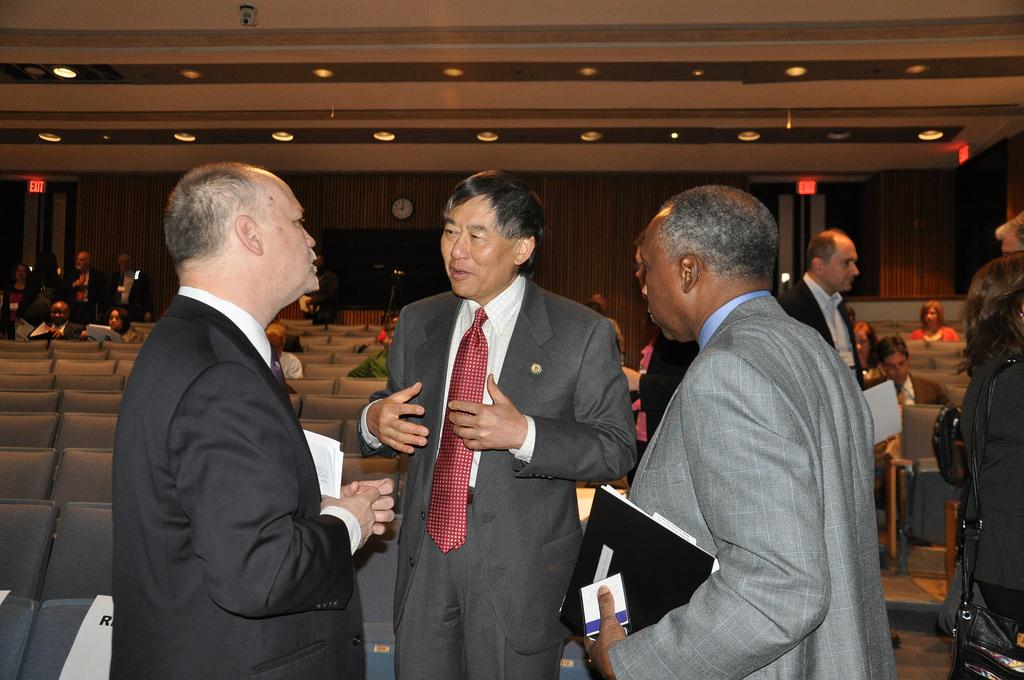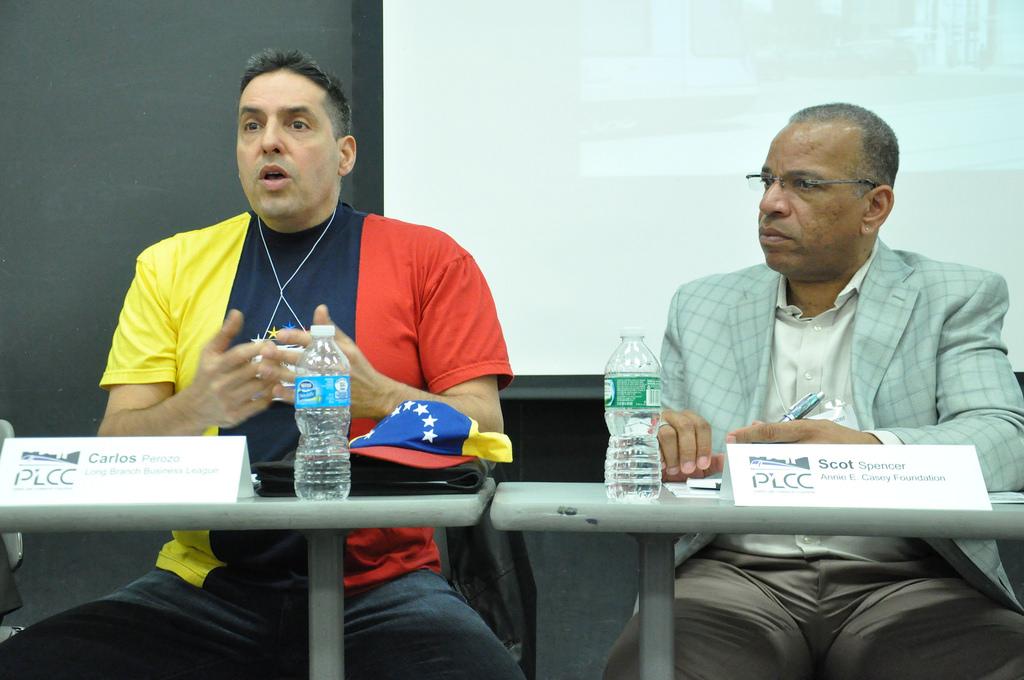Over 260 community stakeholders met at the University of Maryland last month to forge a roadmap for creating vibrant, sustainable neighborhoods along the Purple Line, MTA’s proposed light rail system that will connect Montgomery and Prince George’s Counties. Hosted by The Purple Line Corridor Coalition (PLCC), the inaugural regional workshop, “Beyond the Tracks: Community Development in the Purple Line Corridor,” was the first Purple Line-related event of its kind in the Washington region and the largest assembly of community stakeholders since the Maryland Transit Authority announced plans for the proposed 16-mile light rail system.
“One of the problems we have is that when you have a large project that will take place over a long period of time, it will impact and disrupt,” said Montgomery County Executive Isiah Leggett in front of the standing-room only auditorium. “The question for us is, how can we mitigate the disruption? This is a unique opportunity. We need to work collectively to make certain that we take advantage of it.”
“One of the charges that we have is not just to redevelop, but to keep the integrity of the neighborhood intact,” added Prince George’s County Executive Rushern Baker.
The workshop came just days after a record of decision was issued by the Federal Transit Administration, stating that the Purple Line Project satisfied the requirements of the National Environmental Policy Act. With the project now an almost certainty, Friday’s event represented a significant step in helping Purple Line communities plan for diverse challenges and opportunities presented by the new rail line. Hosting national experts in transit-oriented development, including Minnesota Commissioner Peter McLaughlin and former Living Cities Director of Capitol Innovation Robin Hacke, “Beyond the Tracks” was a learning laboratory for stakeholders, exploring case studies from cities that have successfully overcome the challenges and leverage the opportunities associated with the development of a new transit corridor. The event also brought regional experts in housing, economic development, urban planning and design to the table for afternoon break-out sessions that explored topics crucial to the initiative, from retaining local businesses to creating more walkable, vibrant station nodes.
“We were thrilled by the turn out,” said Gerrit Knaap, director of the National Center for Smart Growth, “A lot of work has already gone into preparation by many groups in the region. But, we have a lot of work yet to do in moving the region forward to make sure we’re capitalizing on this investment. That’s what this event is about.”
“This is more than about constructing a rail line. It is more than about pouring concrete and digging dirt. It is also about enhancing communities,” said University President Wallace Loh. “All of the great benefits of the Purple Line, in terms of increasing property values, bringing in new business and more jobs cannot come at the expense of ruining communities.”
The Purple Line will comprise 21 stations between Bethesda and New Carrolton. The event was attended by representatives from virtually every community on the proposed line, as well as large and small business, state agencies, non-profit groups, philanthropic organizations, development groups and local government.
About the Purple Line Corridor Coalition
In 2015, the Maryland Transit Authority (MTA) is expected to break ground on the Purple Line, a 2.37 billion-dollar light rail line that will link communities throughout Montgomery and Prince George’s Counties. The first of its kind in the region, the Purple Line will bring both challenges and opportunities for economic and community development throughout the corridor; while the investment has potential to produce new jobs and more walkable, vibrant communities, it also has the power to threaten the security of local businesses and low-income communities. Research shows that how these communities prepare—and more importantly, coordinate their efforts—will strongly determine future economic development, small business growth, cultural preservation and long-term sustainability.
The Purple Line Corridor Coalition (PLCC) was launched last summer by the National Center for Smart Growth at the University of Maryland (NCSG), in partnership with a contingent of regional partners invested in corridor development. The PLCC is the first major initiative in the National Capital Area; it aims to guide the efforts and expertise of community, government and private business leaders active in planning for the Purple Line corridor, ensuring that the investment in the Purple Line creates vibrant neighborhoods while preserving existing community assets. Comprising over 20 invested special interest groups and government entities, the PLCC provides a platform for collaboration and idea exchange, as well as access to key research, tools and case studies. The PLCC will leverage the NCSG’s analytical capacities—such as mapping, forecasting, research and partnerships with other cities—to help invested groups capitalize on opportunities presented by the Purple Line. This includes actively seeking out market opportunities and identifying vulnerable areas along the corridor where communities can collaborate on best practices. Employing the knowledge base of the NCSG, the PLCC can assist leaders in pinpointing specific goals for both growth and preservation, such as advancing workplace development, preserving affordable housing or promoting cultural assets. The initiative models other successful corridor projects in cities like Denver and the Twin Cities, where partner integration resulted in more financial support, productive joint projects and a better standard of living for those who live and work along transit corridors.
"The coalition's leadership is important to promote equitable investment along the Purple Line," said Melinda Pollack, Vice President at Enterprise Community Partners. "In Denver, Mile High Connects brought together similar partners to ensure that all residents, businesses and neighborhoods benefit from the build out of the light rail line. We have preserved existing and built new affordable housing, encouraged retail opportunities and supported community assets such as public spaces and a library."
To support coalition efforts, the NCSG continues to make significant headway in corridor research. An interesting finding discovered by researchers is that the Purple Line creates an enormous impact of connectivity system-wide—from Washington to Baltimore to Annapolis—not just within the Purple Line corridor. Researchers have created several corridor maps that show property types, demographics and nearby employment centers, which are clues to how MTA can increase ridership. Specialized mapping can also identify local businesses and affordable housing that will be at risk for raised land prices, allowing groups to mitigate losses before they happen.
“Everybody knows that major investments in transportation infrastructure, like the Purple Line, can shape the growth and character of regions for decades if not centuries in the future,” explains Knaap. “But it will take a concerted and coordinated effort by the public, private and nonprofit sectors to make sure that we capture the economic and community development benefits without imposing undue harm on the culturally rich but economically fragile communities that dot the corridor.”
The PLCC operates in partnership with a small consortium of community organizations, private groups, local government and other university programs. They are: The University of Maryland Division of Administration and Finance; The National Center for Smart Growth; Maryland Transit Administration; Enterprise Community Partners, Inc.; The School of Architecture, Planning and Preservation, UMD; CASA de Maryland; Montgomery Housing Partnership and the Shared Progress Collaborative; Colvin Institute for Real Estate Development; Maryland Department of Housing and Community Development; Montgomery County government; Prince George’s County government; A. James Clark School of Engineering, UMD; Metropolitan Washington Council of Governments; ULI Washington; Chevy Chase Land Company; and Lee Development Group, Inc.
For more information on the Purple Line Corridor Coalition, visit the PLCC website at http://purplelinecorridor.org/.




